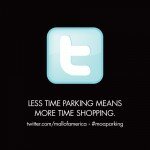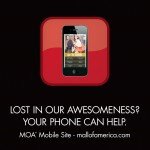I’ve resurrected this from blog post purgatory, also known as my draft box. This post has been in draft since 12/11/11 and I thought that marketers using the lone social media icon in really important places they pay a lot of money for (collateral and advertising) would have stopped by now, but in fact it’s only worsened.
You see it everywhere. The use of Facebook, Twitter, YouTube (insert social icon here) icons with no URL attached and no call to action and/or value proposition. In most places it appears as though marketing departments have checked social media off the list because they threw the Facebook and Twitter, etc. icons on their collateral and advertising. This needs to stop.
Much like we’ve advertised 800 numbers and websites to drive relationships and sales, social media offer us additional places for consumers to interact with our business. It only makes sense that we should communicate this clearly so it doesn’t turn into a missed opportunity. When we put 800 numbers in collateral or advertising, there’s usually a “Call xxx-xxx-xxxx for X,” a clear destination and call to action of why to call and what you’re going to get when you get there. Similarly, websites are promoted with language like “Visit www.blank.com for X.” We need to be approaching social with the same strategic lens so that we capitalize on the opportunity these communication channels present us. This seems like common sense, but it is not common practice in social media. One of the biggest mistakes I see in [digital] marketing is the assumption that consumers recognize and know how to use new mediums to connect with brands. So, let’s think about them a little bit more when we’re building out our mar comm efforts. It will be better for everyone that way:-)
Let’s look at few examples:
Walk to End Alzheimer’s TV commercial
Instead of making their advertising dollars go the distance, they’ve chosen to advertise for Facebook, Twitter and YouTube. The lack of putting /alzwalk after the Facebook icon, @alzassociation after the Twitter icon and whatever its YouTube vanity URL is a huge loss because let’s be realistic, few average consumers are going to go search for your presence in those places and let’s say they do, if it’s hard to find they’ll give up quickly.
Wedding Day Diamonds TV commercial
Once more, this is like dual advertising for Wedding Day Diamonds and Facebook and Twitter.
Suits print ad
Lone social icons next to URL.
Belvedere Vodka print ad
Lone social icons.
Board up for Lili’s Salon and Spa at The Galleria (mall) in Edina, Minn.
A QR code with the salon website placed above it (so smart) and the Facebook and Twitter vanity URLs above the Facebook and Twitter icons. Well done Lili’s Salon!
Verizon TV commercial
Love the use of Facebook vanity here.
48 Hours episode on CBS
48 Hours provides call to action (Chat Now on Facebook) and great links to Facebook and Twitter profiles.
WCCO News at 10 w/ Jason DeRusha and Liz Collin
I think that Jason and Liz do a great job socializing the Sunday evening news. As part of their segment, they ask the audience to use their hashtag and handles (prominently displayed on the screen long enough for you to absorb it) to answer a question. They then share a few viewer tweets at the end of the broadcast.
Mall of America print and on-mall signage
When I was at Mall of America, I transformed the lone social media icon into a series of ads for Facebook, Twitter, the MOA Blog and mobile website. The point was to raise awareness of MOA’s social channels, what consumers could expect to find there and the exact road to get there if they so choose. I suggest you do the same. It’s a relatively simple step compared to everything else we do:-)
Social media is still in its infancy and folks are unclear on how to approach its use and how to communication it to their respective audiences. We’re not going to tackle all of that here, but one of the most important projects you can undertake is defining how social fits into your brand’s ecosystem, traditional and digital. Here are a few helpful tips to get started:
- Define why you’re in social and how that relates back to your mar comm strategy
- Understand what each social channel (Facebook, Twitter, Pinterest, Google+, etc.) will represent
- Develop supporting communication in the appropriate touch points
I know you guys have stuff to add. Please add to the list.


![photo 1[1]](/wp-content/uploads/2012/07/photo-111-225x300.jpg)










 I create purpose-driven experiences that establish meaningful connections between people and brands through the convergence of technology and communication.
I create purpose-driven experiences that establish meaningful connections between people and brands through the convergence of technology and communication.





